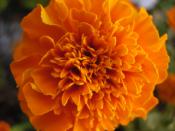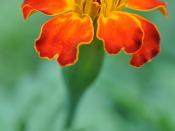Review of Literature
Plants are organisms that, like everything else that is living, are made up of cells and they are in the Plantae Kingdom (Plants, p. 2893-2894). The earliest know plants that occurred were the ferns, and they appeared about 400 million years ago (Plant, 1996). Plants get their energy from the sun by a process called photosynthesis and take in food and water by their root system. Then it travels up the stem and to the leaves and/or flower (Plants, p. 2894, 2896).
If your plant looks sick it probably has a disease. Plant diseases can be infectious, meaning transmitted from plant to plant, or noninfectious. Noninfectious diseases are called disorders and are most common among plants. Some disorders are caused by lack of nutrients, too much or too little water, polluted soil, or polluted air. Weather can effect a plant's growth too, for example: too much or too little sun (Plants, p.
2904)
Marigolds are popular half-hardy annuals that are grown for their bright, wide flowers and bushy mounds of lacy, green leaves. The African or American Marigolds (Tagetes erecta) are large with 18-36 inch long stems. They have large flowers about two to four inches wide that are yellow, orange, or bicolored. The French Marigolds "are much daintier", with small single flowers that are also about two to four inches wide. They come in yellow, red, and orange. There are also Hybrids, that are a cross between the two species. The seeds of a Hybrid have a much lower germination rate than the American and French Marigolds. The some that do sprout have tall plants that have to be removed so they will not "detract from the others". The Hybrids don't set seed, so their flowers last longer (Proctor, p. 98). Some other species are the...



Good job
Well done and well written.
4 out of 4 people found this comment useful.